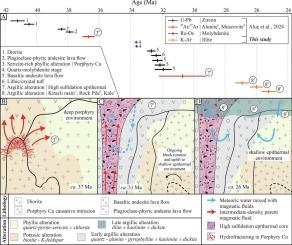甘肃比加半岛基拉兹利尔斑岩浅成热液矿床的叠置成矿与热液蚀变
IF 3.6
2区 地球科学
Q1 GEOLOGY
引用次数: 0
摘要
kirazlyi矿床位于比加半岛的中心,是本文章由计算机程序翻译,如有差异,请以英文原文为准。

Superimposed ore formation and hydrothermal alteration at the Kirazlı porphyry-epithermal deposit, Biga Peninsula, NW Türkiye
The Kirazlı deposit, located at the center of the Biga Peninsula, is one of the superimposed high-sulfidation (HS) epithermal Au-Ag and porphyry Cu systems in Türkiye. Ore formation and hydrothermal alteration at the Kirazlı were developed in 4 stages from oldest to youngest: (a) porphyry Cu, (b) re-opening base metal, (c) quartz-molybdenite, and (d) HS epithermal Au-Ag. Superimposed features of hydrothermal alteration are recognized in QEMSCAN mineral maps, suggesting progressive overprinting by an epithermal-related alteration on a porphyry Cu-style alteration. The sulfur isotopic compositions of the porphyry Cu and HS epithermal Au-Ag stages range from – 0.3 to + 3.7 ‰, and from −1.9 to + 0.1 ‰, respectively. Although magmatic input is observed in the generation of both deposits, the compositional gap and much lower δ34S values of the HS epithermal Au-Ag ore body are attributed to different hydrothermal fluids that overprinted the earlier porphyry Cu system. The coexistence of multiphase highly saline fluid inclusions with vapor-rich inclusions indicates boiling during early porphyry Cu mineralization. The low-temperature and low-salinity fluid inclusion assemblages trapped in a later stage indicate overprinting hydrothermal activity. Hydrogen and oxygen isotopic compositions of illite and muscovite from the phyllic and argillic alteration zones indicate that the ore-bearing fluids at the Kirazlı consist of a magmatic and meteoric fluid mixture, with a dominant magmatic component during the porphyry event. A K-Ar age of illite from late argillic alteration is ca. 26 Ma, suggesting that hydrothermal activity at Kirazlı continued after the formation of the HS epithermal deposit.
求助全文
通过发布文献求助,成功后即可免费获取论文全文。
去求助
来源期刊

Ore Geology Reviews
地学-地质学
CiteScore
6.50
自引率
27.30%
发文量
546
审稿时长
22.9 weeks
期刊介绍:
Ore Geology Reviews aims to familiarize all earth scientists with recent advances in a number of interconnected disciplines related to the study of, and search for, ore deposits. The reviews range from brief to longer contributions, but the journal preferentially publishes manuscripts that fill the niche between the commonly shorter journal articles and the comprehensive book coverages, and thus has a special appeal to many authors and readers.
 求助内容:
求助内容: 应助结果提醒方式:
应助结果提醒方式:


